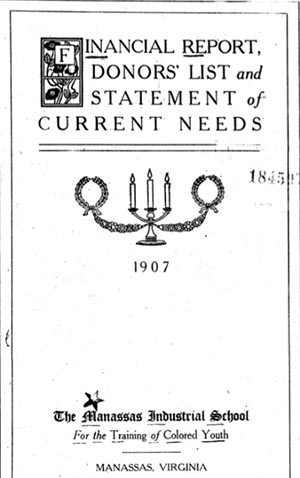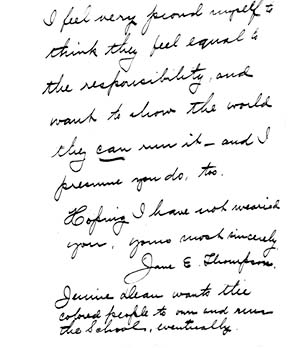Conflict
Money
The Manassas Industrial School was always in dire need for more funding. It had multiple fires that caused extra stress on the resources of the school. The success of the school was demonstrated in the large growth of the number of students and faculty but this also added to the strain on the resources. Jennie Dean remained a tireless missionary and tried to attract new donors. There were lots of small donors from the area but the large donors were mostly Villard supporters. Villard wanted Dean to have less control over the school because he saw her as part of problem. Dean and the locals, in Villard's eyes were mismanaging the resources and in 1908 he hired an accounting firm to demonstrate this to the board and other supporters.

New York Public Library
Control
Dean was aided by her long time friend and board member Jennie Thompson. Thompson was a southern white woman who had been Dean’s biggest supporters since the school opened. It was probably through her connection that the MIS became connected with some of the leading feminist organizations and leaders of the time including Susan B. Anthony, in the early years of the school, and Emily Howland. Thompson wrote to Howland quite often trying to drum up support, both financial as well as for the ideas of Jennie Dean. It is from these correspondence that we can see the extent of the factionalism that existed between the two sides. It is unclear if Emily Howland took any particular side during the infighting that took place, but she did tend to give individual donations to Jennie Dean herself and it seems that she was sympathetic to the cause of Dean and Thompson.
Letter from Thompson to Howland
Emily Howland Papers Cornell Univ.
Thompson argued that Villard and others ignored the political realities that existed on the ground in Manassas and relied on the advice of experts like B.T. Washington. Further, there is a hint that these men did not understand the needs of these schools because they looked down upon women as leaders of the institutions. Thompson makes the point in several letters like the image above that Dean and the local African American community believe that they are fit and able to own and run the school themselves eventually. It seems that the school continued to wrested from control from Dean and the local community and this caused great resentment on both sides. Thompson writes
“...with wealthy man like Mr. Villard as president the last five years of her [Dean] life should have been the happiest, but unfortunately they were not and the reason was that after having been president three years from 1905 to 1908 ...he evolved an ambitious Tuskegee scheme which distressed her and the colored people of northern Virginia generally who were instrumental in starting the school for there is this difference between the Manassas Industrial School and schools like Tuskegee and Hampton,-that the movement started from among the colored people of the Bull Run region themselves led by Jennie Dean to have a school of their own.” 1
The Black community felt that Dean deserved better treatment by the leadership and that the fact that she was not treated well was a reflection upon the lack of sensitivity and awareness to the sacrifices and ideas of the black community itself. These people actually believed that their school was different in its origins, it philosophy and its legacy than the Hampton-Tuskegee model. They had provided much of the schools early financing and they were instrumental in the construction and furnishing of the school through their donations of both financial capital as well as the physical capital such as tools, furniture and other necessary items for a school to operate. The African American community felt that they had been slighted by Villard and his philanthropic friends. Thompson writes, “I wish to give Mr. Villard full credit for all he has done, and if he had carried the colored people of Northern Virginia along with him in co-operation and sympathy it would have been excellent work: for he worked hard, yet with an arbitrary method that alienated the colored people from the work...”2 Eventually, the aggitation against Villard forced him to resign from his position as President of the board of directors on March first, 1913. However, he remained a significant part of the leadership through his role as a board member. In his place Dr. Winfield Scott Montgomery was elected to serve in his place. Dr. Montgomery was the first African American to serve in that capacity. Even after Villard resigned he used his poition and his allies in order to aggitate and to try to minimize the local communities control over the direction of the school.
1Letter from Ms. Jane E. Thompson to Theodore Roosevelt June 15,1913 in the Theodore Roosevelt Papers
2ibid
(Back to top)NEXT
